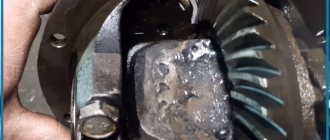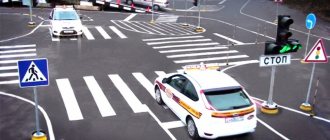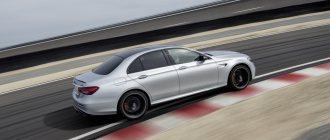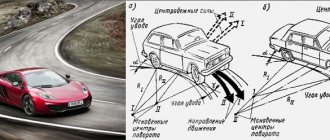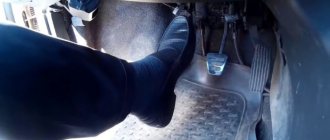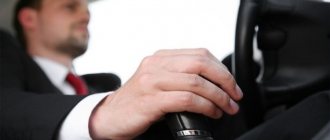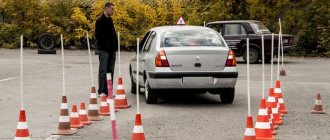Learning to move uphill without straining
Once, I had to observe the broken front of a Gazelle, antifreeze leaking from the radiator, and the upset driver of the damaged car. Formally, he was at fault: he didn’t keep his distance, he drove up too close.
But, considering that a car rolled onto him, the driver of which was moving poorly on the uphill, he had no chance of avoiding this accident. From the word absolutely. The hill at the traffic light was quite steep and the distance would have to be kept more than ten meters. Which is simply impossible in dense traffic.
How to drive uphill with a manual transmission
Safely. In order to confidently make a climb, it is necessary, as you approach it, to decide in which gear you will perform the maneuver. If the slope is not steep or short, then the one on which you were driving on a flat road will suffice. Most often it happens that the gear needs to be changed to a lower one. You can, of course, slow down in advance, switch to 2nd or even 1st gear and climb up at a crawl. But this method will take a lot of time, consume a lot of fuel and wear out engine parts. Therefore, gears are usually changed on an incline. This should be done using the so-called re-throttle, which is performed at a time when the engine speed begins to fall, but the car is still actively moving up without a noticeable decrease in speed. No matter what happens, in any situation, our on-site technical assistance specialists on Moscow roads will come and provide the necessary assistance.
A safe way to drive uphill with a manual transmission
depends on the location of the vehicle on the road. As you approach the top of the hill, try to move as far to the right as possible, without driving onto the side of the road, especially dangerous and loose ones. Once you reach the top, carefully assess the situation and obstacles ahead of you. And in one of the next chapters you will learn how to change lanes in heavy traffic if changing lanes in heavy traffic makes you afraid.
And further. A few words about the stop. Stopping and parking on an incline (if for some reason you had to do this) should only be done in a clearly visible area, where there are no sharp turns or other obstacles that block the driver’s view.
Never leave the car locked only with the parking brake; be sure to engage 1st gear. If there is a curb on the rise, try to turn the front wheels in its direction: this will prevent the car from rolling backwards in a straight line; it will simply rest its rear wheel against the curb. When parking for a long time, it is advisable to place stops under the wheels - large stones or non-round logs.
Traffic rules In that part of the traffic rules that concerns driving on an incline, overtaking is prohibited." at the end of a climb, at dangerous turns and in other areas with limited visibility” (paragraph 114).
Source
We move up the hill smoothly and without jerking
Let's try to learn how to start on a hill, if this skill has not yet been honed to automaticity. With practice, so-called muscle memory appears and you will no longer need to remember the order of actions. The legs themselves will remember what movements to make. And your hearing will tell your head when to press down on the gas pedal and smoothly move forward.
You will learn to feel your car and this skill will not leave you anywhere. It's like riding a bicycle or skating - once you learn it, you won't forget it.
Every skill comes with practice. To drive, you need to drive and there are no other recipes.
The more often and longer the trips, the better and faster the driving skill will take root. The ability to correlate the capabilities of the car with the condition of the road will come, and so on and so forth.
You can rest assured that the ability to move away on an uphill slope smoothly and without jerking will definitely come.
Even if now you really want to cry when the car stalls or jumps, instead of moving smoothly upward. You will know on a subconscious level how to press the gas pedal, when to change gear and when to move your foot from the brake to the gas. All this will definitely come and stay with you forever.
How to avoid jerks?
Jerks occur due to insufficient smoothness of actions. The main mistake of all beginners is this:
- sudden release of the clutch;
- insufficient crankshaft speed;
The driver must train the left leg so that it can hold the pedal in a given position for a long time. Beginners release the pedal halfway and then activate the transmission-engine connection too quickly. The disc suddenly meets the flywheel and the car starts jerking. It is important to learn to drive so that the car does not jerk.
The second case occurs when the driver does not press the gas when starting to move. Especially when the car is heavily loaded and when driving up a high hill. If the vehicle is loaded or used to tow another vehicle. It is necessary to increase the crankshaft speed in advance, and then smoothly release the clutch to achieve a smooth start. These steps will help maintain the tow rope and teach you how to start with a load or uphill.
Let's start on an uphill climb without rolling back
The most difficult areas for us, the ladies behind the wheel, will be those with a large inclined angle. It was also difficult for me because my feet are small and my feet are narrow. Therefore, at first I kept getting caught when moving my foot from the brake to the gas between the pedals. Then this problem disappeared on its own. The leg remembered what movement it should make in order to land exactly where it should.
Universal algorithm of action
In driving school they teach you how to use the handbrake. Well, it has the right to life - let’s look at this method now.
You are on a climb, the engine is running, the handbrake is locked, the gearshift lever is in neutral.
- Depress the clutch and engage first gear.
- Lightly press the gas pedal.
At the same time, we bring the engine speed to 2500 rpm. Fix the gas pedal in this position. If you don’t yet have the ability to listen to the engine and determine by the sound the desired degree of holding the gas pedal, then we focus on the number of revolutions (the device, by the way, is called a tachometer). - Now release the gas pedal very slowly. This must be done smoothly and without jerking. We also release the clutch very smoothly. If you suddenly release the pedal, the engine will stall. We release the clutch until the speed on the tachometer shows approximately 1500 revolutions.
- Now the most important point - let go of the handbrake. If everything is done correctly, then you will move off without any problems. And remember - everything is done smoothly. Sudden movements will cause the engine to stall.
Let's go uphill without a handbrake
Everyday, common and, in my opinion, most acceptable.
- Starting position: gear shift lever in neutral, right foot on the brake pedal, handbrake not fixed (we don’t remember about it at all now, it’s not there and that’s it).
- First, depress the clutch and engage first gear. We made sure that nothing will interfere with the movement, we proceed further.
- Smoothly (smoothly!) release the clutch pedal until you hear the sound of the load on the engine (the brake is pressed). By the sound of the engine and by the slightly dropped speed on the tachometer, you can determine whether the clutch has engaged.
- The main thing with this method is to practice smooth movement of the clutch pedal
. If you suddenly “release” the clutch, the engine stalls. This sad thing is familiar to every novice car driver, and certainly to lady car drivers. All the ladies I know considered the clutch pedal, at the learning stage, enemy number 1. - Now release the brake (the clutch pedal is in the same position). Quickly, but smoothly, we throw our right, freed leg onto the gas, press the gas pedal and, lo and behold! - We move off elegantly.
That's it, the ability to feel the car has arrived and the ability to move away on an incline too. You can be proud of yourself, now you will enjoy driving and feel like an all-powerful tamer of an iron horse.
Likes 10
How to drive up a mountain in a front-wheel drive car?
Today we will not talk about the advantages of front-wheel drive over other types of drives.
Today we will discuss the question of how to drive up a mountain in a car with front-wheel drive. The easiest way to do this, of course, is in a car with all-wheel drive; cars with a driven rear axle come in second, since when starting they squat, the load on the rear wheels increases, and the tires cling to the surface better. When climbing a mountain or a steep slope, you need to take into account that each machine has its own maximum climbing angle. The taller the car, the higher its center of mass and the more likely it is to roll over. Off-road experts say that it is more difficult to tip over if you drive straight rather than diagonally. There is also an opinion that it is easier to drive uphill in a car when accelerating. In the case of an all-wheel drive car, this may be true, but a car with front-wheel drive behaves slightly differently. For a car with front-wheel drive, when going uphill, traction is more important than speed, so it is more advisable to use first or second gear. In addition, at high speeds the turbine will turn on and the power will increase.
When driving uphill at speed, the drive axle of a front-wheel drive car is unloaded, and the front wheels, having lost support, begin to turn. A little too much gas, and the wheels will slip. The beginning of the front axle slipping is a litmus test, or a signal that it is time to slow down and stop, the car will not go any further anyway.
At such a moment, you need to release the gas pedal a little, and when a minimum part of the weight is transferred to the front axle, the traction of the wheels with the surface is restored. Now you need to gradually add gas, while keeping the steering wheel straight, slightly rocking from side to side.
But there is another method (way) to drive up a mountain in a front-wheel drive car - turn it around backwards. When starting in reverse, the weight of a front-wheel drive car loads the front axle, which, once at the bottom, will behave like the rear axle of a rear-wheel drive car. Yes, driving a car uphill backwards will be a little more difficult, and this is where a rear view camera comes in handy.
The idea of driving backwards is not new. Experienced motorists use it when the road is slippery and it is not possible to drive uphill in a front-wheel drive car in the usual way. However, for novice drivers this method is not the most effective and is quite dangerous. If you lose control, the car can easily turn across the road and capsize. Don’t scale unbearable heights and remember the proverb: “A smart person won’t climb a mountain, a smart person will walk around a mountain!”
Source
2: retracting box
The ideal way to feel the grip is by practicing on a matchbox. The assistant places an open matchbox in the frame of an open window or against a mirror. The driver’s task is to push it in as smoothly as possible.
The task can be complicated if you do it on a hill or the same ramp. The rollback will be immediately visible visually. Not all drivers will handle this exercise perfectly.
Maintain safety as attention is distracted by the boxes.
Reasons why a car rolls at speed on a slope with the engine turned off
Often the car is stopped in an area where the road is downhill or uphill. If the parking brake does not work, you can hold the car in place in gear with the engine not running. This doesn't always work out. The reasons are as follows:
- The clutch is slipping. To eliminate this, it is necessary to adjust the gap between the fork and the working cylinder.
- The clutch disc does not hold well. It needs to be replaced.
- Timing belt slippage.
- Low compression in cylinders. The car begins to slowly move downhill in jerks.
There is always a fault in the car that needs to be fixed.
Machine
Every day, the automobile industry increasingly produces cars with automatic transmissions. This type of gearbox is more popular among motorists. But it’s true, if you have an automatic transmission, movement becomes a fairy tale, and you don’t have to think about what and how to press.
And indeed it is. But making the ascent in a vehicle that has an automatic transmission, not new, but previously used, is not so easy. When a steep hill is in sight, any motorist should know to shift into D or L because there is not enough power. But after fifteen minutes of driving at a speed interval of 20 km/h, the light begins to blink, indicating overheating. And if you stop on a slope, it will not be possible to continue moving. In such situations, it is recommended to promptly change the fluid and pay attention to the radiator.
If we take into account new models of vehicles with an automatic transmission, then when driving uphill, they do not have problems like current ones. Even in the case of forced restrictions in shifting the gearbox, but not higher than third gear and with maximum load, a car with an automatic transmission performs perfectly uphill. The same can be said about going down a slope. Motor vehicles are very good at slowing down using the engine, automatically switching to low gears.
If there is a very steep descent, it is recommended to engage the limit and preferably before second gear. And with this option, the vehicle will consume significantly less fuel, revving up the engine using kinetic energy (directly spare).
Now let's look at tugs based on automatic transmission. As you understand, this is not a manual transmission, and a car with an automatic transmission has some kind of limitations that you need to know about and always remember. And this applies not only to towing other vehicles that are subject to restrictions. Such a restriction sounds like this: it is allowed to take in tow only those vehicles whose weight is less than the main one. For example, it could easily be a small trailer. Although vehicles with automatic transmission move much slower with other cars in tow, they perform the task very well. True, here too you need to control overheating.
Clutch pedal positions
The clutch pedal has 4 main positions. For visual perception they are shown in the figure.
The distance from position 1, when the clutch is completely disengaged, to position 2, when minimal clutch occurs and the car starts to move, can be called an empty stroke, since when the pedal moves in this interval, nothing will happen to the car.
Range of motion from point 2 to point 3—adhesion force increases.
And the range from 3 to 4 points can also be called empty, since at this moment the clutch is already fully engaged, the car moves according to the selected gear.
Which gear is better to leave the car in?
The downhill side must be taken into account. If the front of the car is pointing down a hill, then engage reverse gear. It is believed that this will better protect the car since it is designed for traffic in the opposite direction.
When parking a vehicle on a hill, it is better to engage first gear. The reason is of the same nature. In addition to it, all other forward gears can be used, but they will hold the car weaker, since the gears of these speeds turn more easily.
When parking your vehicle on a flat surface with the engine not running, you can engage any gear and safely leave the car.

